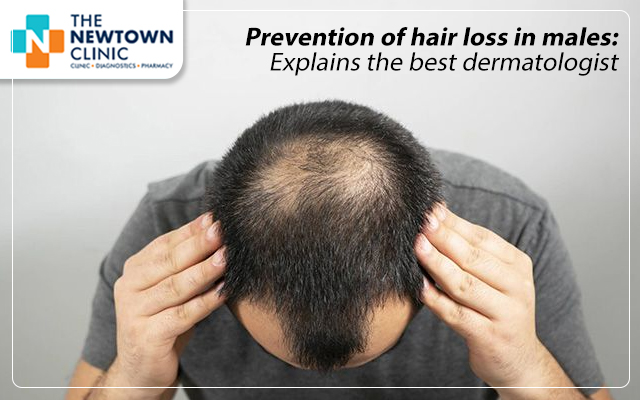Table Of Content

Uniquely designed with multiple plant growth factors cultivated through advanced stem cell technology, this serum nourishes hair follicles and promotes healthy hair growth at the root. During your appointment, the dermatologist will ask you questions about your hair loss and overall health. They’ll ask how long you’ve noticed the hair loss, whether you’re taking any medications, and if you have a family history of hair loss or baldness. Hair loss may seem like a simple cosmetic issue, but it can also signal a more serious health problem.
Procedures used to treat male pattern hair loss
Various treatments have been examined as potential methods to mitigate hair loss. A dermatologist can also tell you what results you can expect from treatment. If you want to treat the hair loss, a dermatologist can talk with you about options that will help you see the most improvement.
How can I stop my hair from thinning?
To treat these changes in an adult, a dermatologist may prescribe medication like a corticosteroid or tazarotene, which you apply to the nails. Another option is to inject the changed nails with a corticosteroid or prescribe corticosteroid pills for a short time. A board-certified dermatologist can often diagnose this disease by looking carefully at the area(s) with hair loss and your nails.
Dermatologist-Approved Treatments For Hair Loss
A variety of treatments have been developed to help regrow hair and thicken existing hair on patients with alopecia, dermatologists say. Their effectiveness largely depends upon what type of alopecia you have and how quickly you start treatment. The most common cause of alopecia is an inherited condition called male- or female-pattern hair loss.
stress
Discover the signs of this common cause of hair loss and what can treat it. If your blood test reveals that you’re not getting enough biotin, iron, or zinc, your dermatologist may recommend taking a supplement. If you’re not getting enough protein, your dermatologist can tell you how to boost your intake. It’s essential that you not become pregnant while taking spironolactone. To prevent pregnancy, your dermatologist will also prescribe a birth control pill if it’s possible for you to get pregnant. Within the first few months of treatment, you may notice that you are losing less or minimal amounts of hair.
Hair Loss Treatment for Women & Men
Whether you decide to take the OTC route or consult with a dermatologist, the AAD stresses that hair loss is complex and there’s no one-size-fits-all regimen. It may take some trial and error to narrow down which combo of hair loss treatments works best for you, but the above derm-recommended options will, hopefully, encourage your strands to make a comeback. This man took finasteride to treat his male pattern hair loss, and within 1 year (B), he had noticeable improvement. This is considered the most effective treatment for people who have a few patches of alopecia areata, a condition that causes hair loss.
Laser Therapy
By injecting the steroid into the scalp, dermatologists help with inflammation and improve overall growth. For significant scalp inflammation, Dr. MacGregor adds pulsed topical steroid solutions into the mix, which is “a stronger topical steroid application” that is limited to once every one to two weeks. “It’s rubbed into the scalp, then you’ll sleep overnight with a shower cap, before washing it out in the morning with one of the medicated shampoos, leaving it on for five minutes before rinsing,” she explains. If the shedding is new, worsening, or severe, if your scalp is bumpy, itchy, or significantly red, if you have bald patches, or if your ’do is not responding to general hair care measures, Dr. MacGregor says it’s time to book.
Try some PRP Therapy
Can Anti-Dandruff Shampoo Prevent Hair Loss? - Health.com
Can Anti-Dandruff Shampoo Prevent Hair Loss?.
Posted: Tue, 19 Mar 2024 07:00:00 GMT [source]
Don't let hair loss rule your life; reach out to a professional and explore the solutions that await you. Whether your hair is falling out in patches or gradually thinning, you're likely looking for ways to cover it up. Should you see regrowth, you will need to keep using it every day. Your dermatologist can tell you whether your hair may start to grow again on its own.

Whether you're dealing with temporary hair shedding or long-term hair loss, a dermatologist can offer a wide range of treatments and strategies to manage your condition. If you’re losing hair, visiting a medical dermatology clinic is one of the best steps you can take. A dermatologist can assess your hair loss and pinpoint a specific diagnosis. If you’re facing prolonged and unexplained hair loss, set an appointment with your dermatologist as soon as possible. Your dermatologist will perform a detailed assessment of your medical history as well as perform a physical examination. You’ll need a blood test to assess your hormones, thyroid, and any deficiencies in some cases.
You may inherit the genes from your mother, father, or both parents. Because many women experience thinning hair and hair loss after menopause, hormones may also play a role. For most women, hair loss begins between 40 and 60 years of age.
Cortisone shots, performed by a board certified dermatologist, can be used to address some forms of hair loss. It is especially effective for treating the common autoimmune disorder alopecia areata, which is when “the body’s own immune system starts fighting hair follicles,” Dr. Engleman says. We’d be remiss not to mention that it can be a doozy of a treatment though.
Because studies show that the following can help, your dermatologist may include one (or more) in your at-home treatment plan. Some hairstyles and hair care habits can damage hair, leading to hair loss. If your dermatologist finds that this may be causing your hair loss, your dermatologist can recommend changes that will help you stop damaging your hair. There is currently no medication available that guarantees that hair will not fall out during or after chemotherapy.

With a range of medical and in-office procedures available, your dermatologist will be able to improve your hair. The first step is to visit your dermatologist to comprehensively review your hair and any skin concerns. However, once you keep up with the scheduled sessions, there will be a significant improvement in hair growth. The old adage ‘you are what you eat’ is especially true when it comes to hair. Optimize your diet with a vitamin D and omega-3 fatty acid supplement to promote healthy growth and avoid high glycemic carbs, as they “increase sebum yeast inflammation in the scalp,” Dr. MacGregor says. Explore Mayo Clinic studies testing new treatments, interventions and tests as a means to prevent, detect, treat or manage this condition.
Here’s how a dermatologist determines the cause and what treatment may involve. After 12 weeks of treatment, the patients treated with minoxidil and microneedling had significantly more hair growth. A treatment plan for hair loss may include one or more of the following. Both the CDC and the FDA warn against treating this common childhood condition on your own with non-prescription treatments. Chemotherapy often leads to alopecia, a prevalent adverse effect.




















